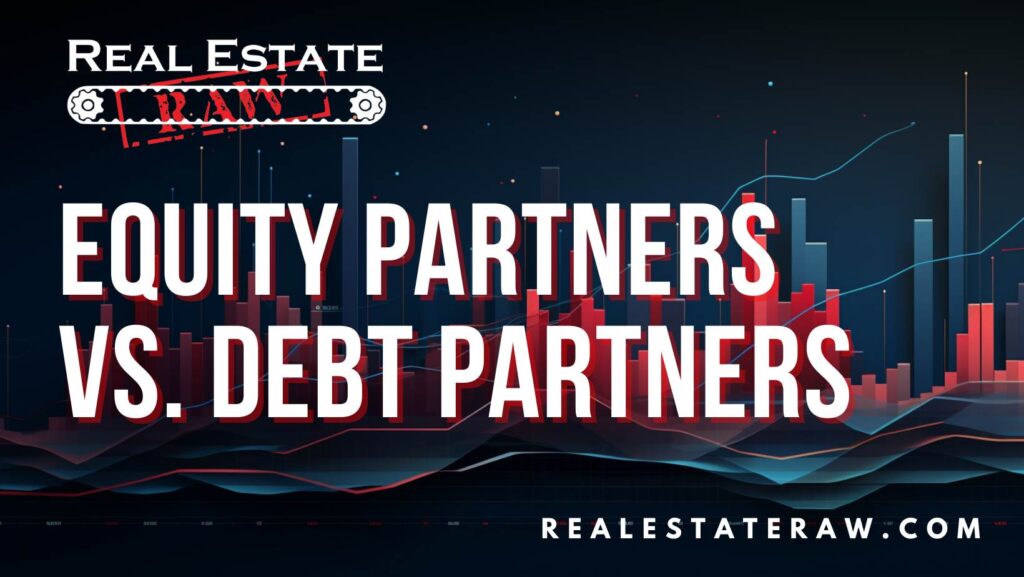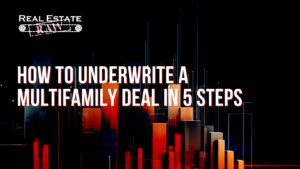While there are many types of investors (partners) in real estate, I will focus on two: equity partners and debt partners. The reason for this is that these two will be the most common structure in most real estate deals.
An equity partner is someone that invests in your deal, and the return on their money is based on the performance of the property and your performance. They own a percentage of the LLC or legal entity that holds title to the property, or they are on the title themselves.
Here’s an example of a syndicated deal. You purchase a property with traditional financing. The lender requires you to put down 20 percent. You don’t have the cash for the down payment, so you go to an investor, and they join you in the deal by providing the down payment and taking a portion of the equity and cash flow. Their return will be based on the performance of the property.
This type of investment is known as syndication, and with it you have likely created a security. There is nothing wrong with this if you do it correctly and you have a Securities and Exchange (SEC) lawyer set it up for you. Depending on the size of the deal and type of investors, attorney’s fees can be expensive, so this may not work for smaller deals due to the setup costs.
This is not a lesson on SEC regulations nor how to syndicate real estate deals. Just keep in mind that if an investor/partner puts money into your deal and has no control over the production of their return, you are likely creating a security.
A debt partner is someone who lends you money to help get a deal done. This person or entity is going to get a set return on their money, which you will determine before you take possession of their cash.
This works just like a bank or any other lender. Debt partners set the interest rate, and you make payments to them each month. Assuming you do not default on the loan, the lender or debt partner will get the same monthly payment regardless of your performance on the property. The equity partner, on the other hand, will get a return that is largely based on your efforts.
Here’s the main difference between equity and debt partners: equity partners do not go away, while debt partners do. Once you exit a deal and pay back a lender, debt partners go away. Once they are paid, the deal is yours.
An equity partner, on the other hand, owns shares or interest in your company and/or property that they have invested in. If you return their capital to them without selling the asset, they still own the equity. Here is an example: You take money from an investor for the down payment and then refinance the property giving them their money back from the proceeds of the refinancing. In this case, they own equity, not debt. If you give them back 100 percent of their invested cash, they will still get an infinite return on their investment until you sell the asset. They don’t go away like a lender. You’ll want to keep this in mind when deciding an exit strategy.
Debt partners want a good return on a safe loan. The interest rate needs to be more attractive than other investments in the market. Once you have found someone willing to lend you money on real estate and have set the rate, you will be securing the loan with the property itself. This is when you need to make a big sales pitch to get someone interested in becoming a debt partner for you.
You want to explain to them that they will be lending you the money to buy the property (and possibly fix it up) and that the money they lend you will be backed by the property itself. They will have a first position mortgage on the property. If you were to default, they would take possession of the property before any other lenders (first position). Be prepared to explain how this type of loan works and what a first position mortgage is.
Some of the best loans come from private lenders. These people may not already be professional lenders and may not know how this works. The more comfortable you can make them with this process, the more likely they are to do business with you. It’s also a good idea to have a business plan for you and for the property. Here are some things to put into the plan for the property:
1. Price (explain why it is a good price)
2. Comparable sales in the area
3. The market and submarket (2-3 miles around the property)
4. The plan for renovations and how that will increase revenue and value
5. Time frame for repairs and lease up
6. Cost of repairs
7. Management
8. Exit strategy and how the lender gets their money back
This business plan is also a marketing piece that can be used to build confidence in you and your project. It’s a way to fully showcase what you are doing and how you will do it.
The last step is to have an attorney create and record your mortgage. I am in an “attorney state” where real estate attorneys do our closings. You may live in an area where a title company would do this. Either way, don’t try and do the paperwork yourself. Have the title company or attorney create the mortgage and facilitate the closing.
How much do you need to borrow from a debt partner?
There are a few formulas that apply to all forms of CSF, not just debt partners. The amount you need to borrow is an important part of these formulas.
After you have analyzed the deal, you will know the cost of the renovations and the amount of operational “rehab” you will need to do, such as raising occupancy or increasing collections. Each one of these tasks will come with a price tag, and you need to know exactly what that will be. This will be the foundation for your financing offer or loan structure.
If you are getting seller financing, then you may need to use the down payment money or raise private money to do the repairs. If you are dealing with only a debt partner, then you will want to raise as much of the total projects cost as possible.
During your initial due diligence on a property, you will get quotes from repair contractors to estimate the amount and cost of any needed repairs (more on this in Chapter 10). Use the quotes you got from the contractors during your analysis to create a loan amount. Show the lender the quotes so they can see how much is needed. Having this number will also help you to explain the overall project to your creditors.
When dealing with multifamily properties that need to be renovated, there is one major mistake I see people making: they underestimate the time that it takes to reach stabilization!
Stabilization is considered 85 percent occupancy or more with stabilized collections. When doing a multifamily rehab job, you need to know how long this will take and how much it will cost. To know this, you will want to consult with local property managers to get a feel for the absorption rate in the local area. This is the number of rent-ready units you can expect to lease up in any given month. This is critical information, as multifamily renovation projects rarely cash flow in the beginning stages of the renovation and stabilization process.
In summary, you will need to know how much the cost of the renovations will be plus the time and cost of stabilization. You may need to have some cash reserves to cover a mortgage payment or the cost of general operation until the property leases up and produces income on its own. Plan carefully!
Here is my general rule for deciding how much money I need for a project:
Purchase Price + Renovation Costs + Refinance Costs ≤ 75% LTV
Translation: You need to buy and fix up and have money to refinance the deal and be less than most lenders acceptable loan to value (LTV). In this case, refinance is the exit strategy. It is usually the most expensive exit strategy. If you plan to sell or assign the property, then calculate for whatever that expense would be. You will need to be familiar with the lending environment in your market, and I will cover this formula more in the Exit Strategy section of the book.
I created this formula to give myself a conservative way to calculate a rehab job. I always calculate refinancing with a traditional lender as the default exit strategy. Always have more than one exit strategy available. If you pay too much or go over your repair budget, you may put a price tag on the property that will not allow you to refinance without using your own pocket money to cover the difference. This will limit your exit abilities. You don’t want to be caught in that situation.
How long do you need the money for?
One of the most important tasks in CSF is making sure you set the agreement up the right way. The length of the financing structure is one aspect to make sure you get it right.
If you borrow money from a debt partner or get financing from an owner, and the loan time isn’t long enough, you can find yourself in a bad situation. Here is my formula for deciding how long to borrow money. This assumes some level of distress and renovation for the property.
Rehab Time + Stabilization Time + Time for Exit = Loan Time
Translation: You will want to create a loan with your debt partner that gives you the time to buy, fix, and exit the deal. In this formula, time to exit means the time it will take to enact whatever exit strategy you are planning. These can include:
1. Refinancing with a traditional lender
2. A sale
3. Assigning the contract (wholesale)
4. Hold and operate
In review, you will want to decide the parameters for your offer and what financing you will accept when you do your analysis of the property. You should also know the cost of the repairs and the duration of the project. Finally, you want to know the time it takes to lease up and stabilize the property.
All this information will come from local property managers. Contact management companies in the area that manage assets like what you are looking for to get current market data. Also let them know you will be needing to hire local management as soon as you close your next deal.
I also suggest taking the total amount of time that you think the project will take and doubling it for the sake of safety. A seller or lender may not be inclined to agree to a longer time frame, so you will have to negotiate the best you can. The longer the financing period, the safer the deal is for you.
Selling and refinancing take the longest time. Before you complete the CSF transaction, you will need to consult with the banks or traditional lenders you plan to refinance with. I will cover this in detail in the Exit Strategy section.
Renovations with Debt Partners
If you are going to take on a distressed asset that needs physical rehab, debt partners are a great tool, but they do come with some risk. Remember, you owe them the money you borrowed regardless of how well your property does or does not operate.
Here’s the problem: Many people underestimate the total price of the renovations. I have done this myself! If you underestimate the cost of the repairs, you may not borrow enough money to bring the property up to an operational level. Unrenovated units will not rent and produce income. You might quickly run out of money to complete the renovations and not have enough rent-ready units to produce the income to pay back the debt partner. This could put you into a foreclosure situation with this private lender.
I have personally been in this situation, and it’s no fun! I underestimated a large renovation job and had to use my personal credit cards to fund the rest of the deal. My first 3 years in real estate were in the single-family space. I had a line of credit with a local bank. I used the money to buy 5 houses with all cash from a single seller.
The houses were basically junk when I bought them. The seller was about to go into foreclosure when my all-cash offer saved her from that. The houses need about $15,000 in repairs to each in carpet, paint, and general repairs. I had planned to use the money from the line of credit to fund the purchase of the assets plus the renovations. Refinance at a different bank when the work is done and pay the original line of credit back.
This was a great idea until I missed my budget on the renovation costs. I was out of cash on the line of credit and had to finish the project with credit cards. I was able to pay back the credit cards from cash flow and the eventual refinance of the property, but that was not what I wanted to do with my money.
Please learn from my mistake and be incredibly careful when estimating the cost of dealing with a distressed asset. Remember that you’re using someone else’s money to do the job (even if it’s a credit card).
Networking for Debt Partners
You never know when you are talking to the “millionaire next door.” I have raised millions of dollars in private funds from people in my everyday environment. To close most of my early deals, I raised over $750,000 from an attorney I knew.
The point is that you never know where the money is going to come from. So, look everywhere. One way to do this is to always be talking about real estate. Let everyone in your world know that you are buying property. Anytime someone asks, “What do you do?” use this as an opportunity to network. No matter what your job is, you are a real estate entrepreneur. I don’t care if you are a doctor or a rocket scientist. When someone asks you this question, answer, “I am a real estate entrepreneur, but in my spare time I am a [fill in your profession].”
When someone asks me this question, I always use it to strike up a conversation about real estate. I buy apartments, so I might enthusiastically say something about going to look at a hot apartment investment. I will be excited but vague, and if the people ask for more information, then I will go into a more in-depth conversation about investing in real estate. I always end the conversation with this remark: “And I’m always looking for partners, if you know anyone that might be interested.”
When starting in the creative and seller financing business, you will run into one common objection: You haven’t done this before, so why should I invest with you?
You will run into this in conversations. You will run into this when you go to do your first large commercial deal. Once you close a deal or two, you won’t hear it anymore.
If you are new to the business and you get this rejection, don’t disagree with the person. Agree with them! Tell them that they are right, you have not done a deal like this before. Then have your education in place to overcome this objection. Showcase the knowledge you have from this book. Discuss your market and why this deal is such a good deal. Discuss your plans for the property. If you don’t have a deal at this point, discuss the real estate market in general and use your real estate knowledge as a résumé.
Your education will carry you to experience. No one starts anything with experience, yet everyone must start somewhere. Just get started.
For more information like this check out my other articles at www.realestateraw.com.
Best of luck!
Bill Ham


































